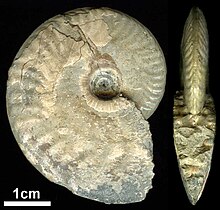Oxycerites
| Oxycerites Temporal range:
| |
|---|---|

| |
| Specimen from Poland | |
| Scientific classification | |
| Domain: | Eukaryota |
| Kingdom: | Animalia |
| Phylum: | Mollusca |
| Class: | Cephalopoda |
| Subclass: | †Ammonoidea |
| Order: | †Ammonitida |
| Family: | †Oppeliidae |
| Subfamily: | †Oppeliinae |
| Genus: | †Oxycerites |
| Species | |
|
see text | |
Oxycerites is an extinct ammonoid cephalopod belonging to the haploceratacean family, Oppeliidae, that lived during the Middle Jurassic. [1]
Shells of Oxycerites are involute, compressed and generally smooth with a sharply rounded venter on the outer rim, deeply impressed dorsum on the inner rim, and a small umbilicus. The living chamber takes up slightly more than half a whorl. Oxycerites grew to a diameter of at least 17.5 cm, about 7 inches.
Oppelia and Oecotraustes are similar and closely related forms. Oppelia is smoother, Oecotraustes more strongly ribbed
Distribution
Jurassic of Argentina, France, Germany, Iran, Madagascar, Russia, Saudi Arabia and the United Kingdom[2]
References
- ^ a b Sepkoski, Jack (2002). "Sepkoski's Online Genus Database". Retrieved 2014-05-28.
{{cite web}}: Cite has empty unknown parameter:|coauthors=(help) - ^ "Paleobiology Database". Retrieved 2014-05-28.
{{cite web}}: Cite has empty unknown parameter:|coauthors=(help)
